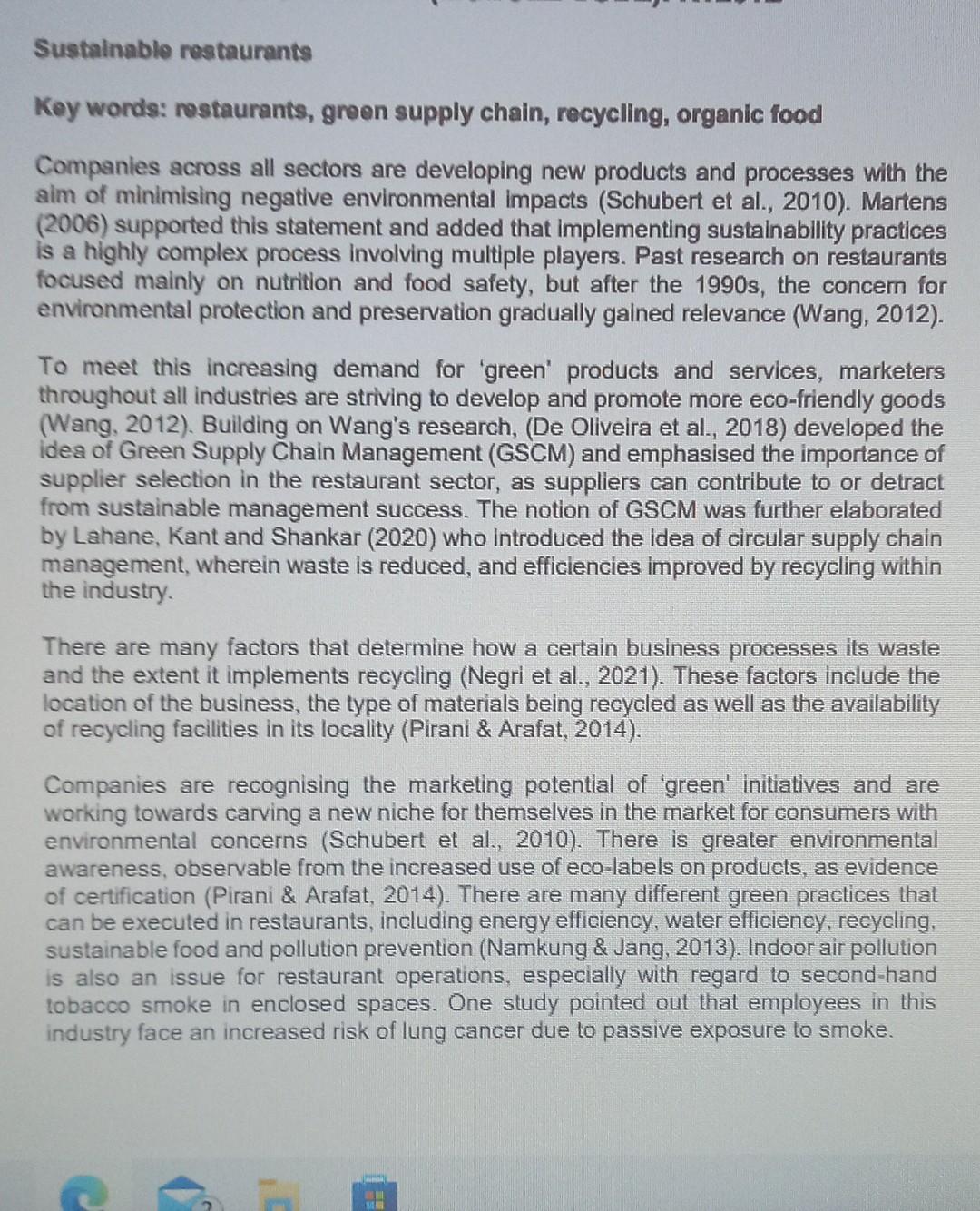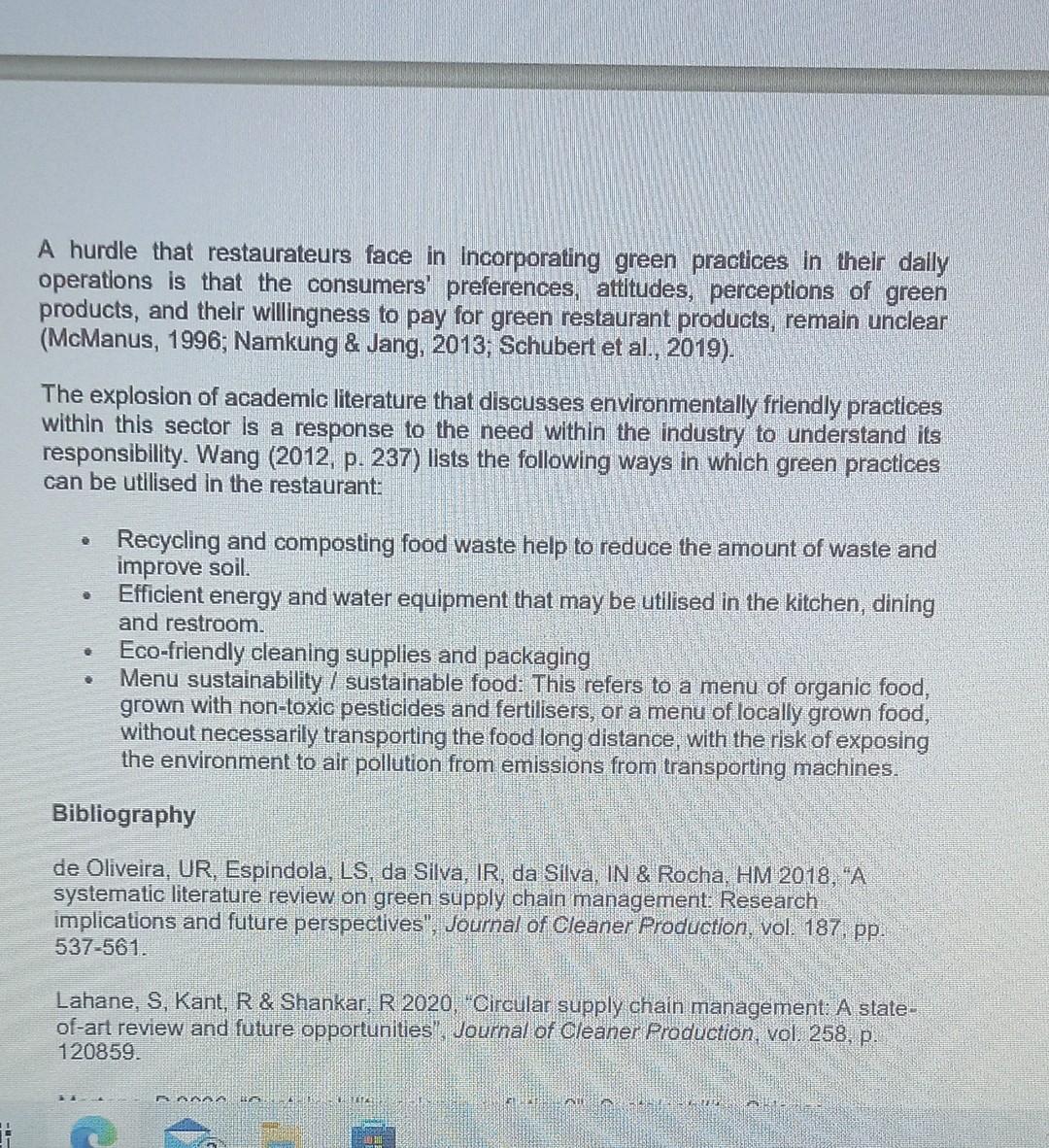Answered step by step
Verified Expert Solution
Question
1 Approved Answer
Sustainable restaurants Key words: restaurants, green supply chain, recycling, organic food Companies across all sectors are developing new products and processes with the aim of



Sustainable restaurants Key words: restaurants, green supply chain, recycling, organic food Companies across all sectors are developing new products and processes with the aim of minimising negative environmental impacts (Schubert et al., 2010). Martens (2006) supported this statement and added that implementing sustainability practices is a highly complex process involving multiple players. Past research on restaurants focused mainly on nutrition and food safety, but after the 1990s, the concern for environmental protection and preservation gradually gained relevance (Wang, 2012). To meet this increasing demand for 'green' products and services, marketers throughout all industries are striving to develop and promote more eco-friendly goods (Wang, 2012). Building on Wang's research, (De Oliveira et al., 2018) developed the idea of Green Supply Chain Management (GSCM) and emphasised the importance of supplier selection in the restaurant sector, as suppliers can contribute to or detract from sustainable management success. The notion of GSCM was further elaborated by Lahane, Kant and Shankar (2020) who introduced the idea of circular supply chain management, wherein waste is reduced, and efficiencies improved by recycling within the industry. There are many factors that determine how a certain business processes its waste and the extent it implements recycling (Negri et al., 2021). These factors include the location of the business, the type of materials being recycled as well as the availability of recycling facilities in its locality (Pirani & Arafat, 2014). Companies are recognising the marketing potential of 'green' initiatives and are working towards carving a new niche for themselves in the market for consumers with environmental concerns (Schubert et al., 2010). There is greater environmental awareness, observable from the increased use of eco-labels on products, as evidence of certification (Pirani & Arafat, 2014). There are many different green practices that can be executed in restaurants, including energy efficiency, water efficiency, recycling, sustainable food and pollution prevention (Namkung & Jang, 2013). Indoor air pollution is also an issue for restaurant operations, especially with regard to second-hand tobacco smoke in enclosed spaces. One study pointed out that employees in this industry face an increased risk of lung cancer due to passive exposure to smoke. J C C A hurdle that restaurateurs face in Incorporating green practices in their daily operations is that the consumers' preferences, attitudes, perceptions of green products, and their willingness to pay for green restaurant products, remain unclear (McManus, 1996; Namkung & Jang, 2013; Schubert et al., 2019). The explosion of academic literature that discusses environmentally friendly practices within this sector is a response to the need within the industry to understand its responsibility. Wang (2012, p. 237) lists the following ways in which green practices can be utilised in the restaurant: Recycling and composting food waste help to reduce the amount of waste and improve soil. O Efficient energy and water equipment that may be utilised in the kitchen, dining and restroom. Eco-friendly cleaning supplies and packaging Menu sustainability / sustainable food: This refers to a menu of organic food, grown with non-toxic pesticides and fertilisers, or a menu of locally grown food, without necessarily transporting the food long distance, with the risk of exposing the environment to air pollution from emissions from transporting machines. Bibliography de Oliveira, UR, Espindola, LS, da Silva, IR, da Silva, IN & Rocha, HM 2018, A systematic literature review on green supply chain management: Research implications and future perspectives", Journal of Cleaner Production, vol. 187, pp. 537-561. Lahane, S, Kant, R & Shankar, R 2020, "Circular supply chain management: A state- of-art review and future opportunities", Journal of Cleaner Production, vol. 258, p. 120859. A 568A RECOBRINCH ALLTA - Having completed the PESTLE framework analysis, what is the most important academic insight related to sustainable restaurant practices that you have gained from having done the analysis? (5) 1 A B I III 33 Sustainable restaurants Key words: restaurants, green supply chain, recycling, organic food Companies across all sectors are developing new products and processes with the aim of minimising negative environmental impacts (Schubert et al., 2010). Martens (2006) supported this statement and added that implementing sustainability practices is a highly complex process involving multiple players. Past research on restaurants focused mainly on nutrition and food safety, but after the 1990s, the concern for environmental protection and preservation gradually gained relevance (Wang, 2012). To meet this increasing demand for 'green' products and services, marketers throughout all industries are striving to develop and promote more eco-friendly goods (Wang, 2012). Building on Wang's research, (De Oliveira et al., 2018) developed the idea of Green Supply Chain Management (GSCM) and emphasised the importance of supplier selection in the restaurant sector, as suppliers can contribute to or detract from sustainable management success. The notion of GSCM was further elaborated by Lahane, Kant and Shankar (2020) who introduced the idea of circular supply chain management, wherein waste is reduced, and efficiencies improved by recycling within the industry. There are many factors that determine how a certain business processes its waste and the extent it implements recycling (Negri et al., 2021). These factors include the location of the business, the type of materials being recycled as well as the availability of recycling facilities in its locality (Pirani & Arafat, 2014). Companies are recognising the marketing potential of 'green' initiatives and are working towards carving a new niche for themselves in the market for consumers with environmental concerns (Schubert et al., 2010). There is greater environmental awareness, observable from the increased use of eco-labels on products, as evidence of certification (Pirani & Arafat, 2014). There are many different green practices that can be executed in restaurants, including energy efficiency, water efficiency, recycling, sustainable food and pollution prevention (Namkung & Jang, 2013). Indoor air pollution is also an issue for restaurant operations, especially with regard to second-hand tobacco smoke in enclosed spaces. One study pointed out that employees in this industry face an increased risk of lung cancer due to passive exposure to smoke. J C C A hurdle that restaurateurs face in Incorporating green practices in their daily operations is that the consumers' preferences, attitudes, perceptions of green products, and their willingness to pay for green restaurant products, remain unclear (McManus, 1996; Namkung & Jang, 2013; Schubert et al., 2019). The explosion of academic literature that discusses environmentally friendly practices within this sector is a response to the need within the industry to understand its responsibility. Wang (2012, p. 237) lists the following ways in which green practices can be utilised in the restaurant: Recycling and composting food waste help to reduce the amount of waste and improve soil. O Efficient energy and water equipment that may be utilised in the kitchen, dining and restroom. Eco-friendly cleaning supplies and packaging Menu sustainability / sustainable food: This refers to a menu of organic food, grown with non-toxic pesticides and fertilisers, or a menu of locally grown food, without necessarily transporting the food long distance, with the risk of exposing the environment to air pollution from emissions from transporting machines. Bibliography de Oliveira, UR, Espindola, LS, da Silva, IR, da Silva, IN & Rocha, HM 2018, A systematic literature review on green supply chain management: Research implications and future perspectives", Journal of Cleaner Production, vol. 187, pp. 537-561. Lahane, S, Kant, R & Shankar, R 2020, "Circular supply chain management: A state- of-art review and future opportunities", Journal of Cleaner Production, vol. 258, p. 120859. A 568A RECOBRINCH ALLTA - Having completed the PESTLE framework analysis, what is the most important academic insight related to sustainable restaurant practices that you have gained from having done the analysis? (5) 1 A B I III 33
Step by Step Solution
There are 3 Steps involved in it
Step: 1

Get Instant Access to Expert-Tailored Solutions
See step-by-step solutions with expert insights and AI powered tools for academic success
Step: 2

Step: 3

Ace Your Homework with AI
Get the answers you need in no time with our AI-driven, step-by-step assistance
Get Started


